terça-feira, outubro 06, 2009
Mercedes Sosa, Piedra y Camino
Piedra Y Camino
Del cerro vengo bajando,
Camino y piedra,
Traigo enredada en el alma, viday
Una tristeza...
Me acusas de no quererte.
No digas eso...
Tal vez no comprendas nunca, viday
Porque me alejo...
Es mi destino
Piedra y camino...
De un sueño lejano y bello, viday
Soy peregrino...
Por mas que la dicha busco,
Vivo penando...
Y cuando debo quedarme, viday
Me voy andando...
A veces soy como el rio:
Llego cantando...
Y sin que nadie lo sepa, viday
Me voy llorando...
Es mi destino,
Piedra y camino...
De un sueño lejano y bello, viday
Soy peregrino...
___
terça-feira, setembro 15, 2009
Ricardo Leite
Na Sala Bocage do Centro de Estudos Judiciários, Largo do Limoeiro, em Lisboa.
Poderá ser visitada das 9h às 18h (dias úteis) até 15 de Outubro.
http://www.ricardo-leite.net/


(para ler - clicar na imagem)
___
Arminda - Performances no Goethe-Institut
" "Arminda" é uma exposição com instalações, vídeos e performances de Gabriel Abrantes, Vasco Araújo, Filipa Brito, Filipa Cardoso, Vera Carmo, António Corceiro-Leal, Sara Correia, Renée Green, Arne Kaiser, Rachel Korman, Dinis Machado, Tiago Mestre, Sofia Ponte & Tiago Pereira, Ana Pissarra, Lara Portela, Flávia Vieira.
"Arminda" é um projecto da Maumaus - Escola de Artes Visuais, que apresenta nas instalações do Goethe-Institut Portugal, em Lisboa, intervenções dos participantes do Programa Independente de Estudos das Artes Visuais a partir de uma residência que estes artistas fizeram durante um mês no Instituto. Foram também incluídas pelos participantes obras já existentes de alguns tutores do programa.
As intervenções terão lugar de 31 de Agosto a 2 de Outubro de 2009 e ocuparão todo o instituto (hall, jardim, salas de aula), interferindo no funcionamento habitual e assim possibilitando novas leituras e olhares sobre o espaço. Há intervenções que só funcionam na área reservada ao ensino da língua alemã, com um público específico, outras (performances) são abertas a todos e acontecem sucessivamente entre as datas indicadas, sendo anunciadas oportunamente por email e nas páginas de internet do Goethe-Institut Portugal e da Escola Maumaus.
O projecto "Arminda" inclui uma midissage no dia 15 de Setembro, às 19.00 horas, no Jardim do Goethe-Institut. "
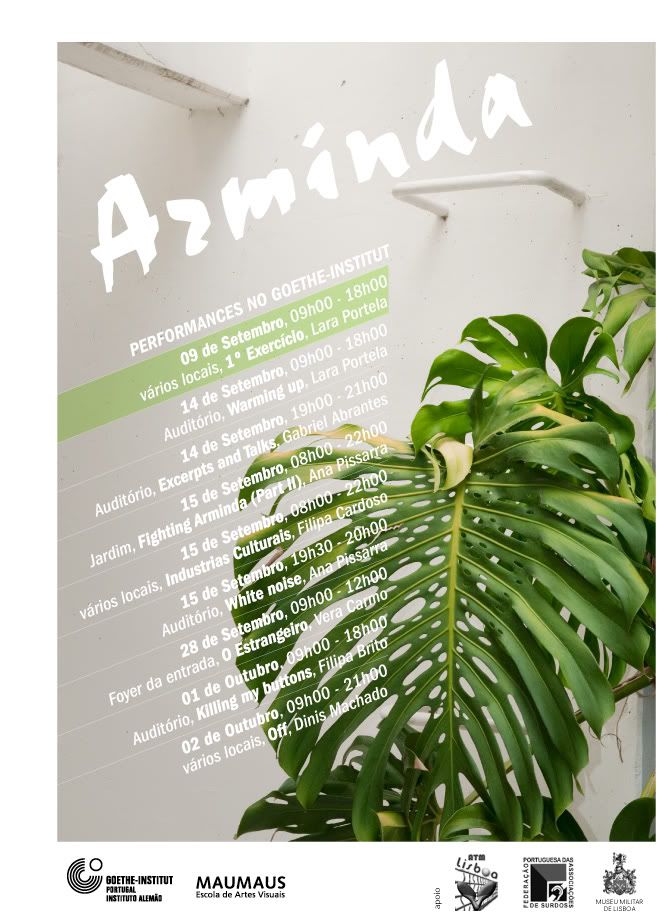
domingo, agosto 09, 2009
Raul Solnado (1929-2009)
sábado, julho 18, 2009
Nina Simone
Nina Simone, Ain't Got No...I've Got Life
(segundo as tags do youtube, em Harlem, 1969)
http://www.ninasimone.com/
http://pt.wikipedia.org/wiki/Nina_Simone
___
quarta-feira, julho 08, 2009
Miles Davis with his nephew Vincent Wilburn, Jr. playing Human Nature in Belgrad 1986
sexta-feira, junho 05, 2009
Home

Hoje, na RTP2, às 20h28.
O documentário também poderá ser visto aqui:
- http://www.home-2009.com/us/index.html
- http://www.youtube.com/homeproject
«HOME - a film by Yann Arthus-Bertrand
We are living in exceptional times. Scientists tell us that we have 10 years to change the way we live, avert the depletion of natural resources and the catastrophic evolution of the Earth's climate.
The stakes are high for us and our children. Everyone should take part in the effort, and HOME has been conceived to take a message of mobilization out to every human being.
For this purpose, HOME needs to be free. A patron, the PPR Group, made this possible. EuropaCorp, the distributor, also pledged not to make any profit because Home is a non-profit film.
HOME has been made for you : share it! And act for the planet.
Yann Arthus-Bertrand»
in http://www.youtube.com/homeproject
___
terça-feira, maio 26, 2009
Close your eyes. You will see
Enviaram-me um mail com o vídeo de um anúncio. Gostei tanto que quero partilhar convosco.
[Já agora, é melhor ouvir qualquer dos vídeos com o som alto... :o) ]
A história que se conta no anúncio é a de uma menina que queria aprender violino.
No fundo, a história tem a ver com a força, com a vontade. Com a Alma.
«Music is a visible thing.
Close your eyes. You will see»
A música é lindíssima. Trata-se do Canon in D (c. 1680) do Johann Pachelbel (1653-1706)
Para a ouvirem, aqui vão 3 versões:
- Canon and Gigue for three violins and basso continuo in D major
Performed by Hesperion XXI
Directed by Jordi Savall
- Canon in D major
Played by The Franz Liszt Chamber Orchestra
- Canon in D major
Performed by Voices of Music
___
sábado, janeiro 31, 2009

Edward Hopper, Nighthawks, 1942, Oil on canvas
The Mysterious Mr. Hopper
(Documentary from the BBC's Imagine series - 2004, Season 3, Episode 1)
___
adenda:
A yko informa-nos que está patente a exposição Western Motel. Edward Hopper and Contemporary Art no KUNSTHALLE wien, até 15 de Fevereiro.
«Hopper’s pictures “deal with America not only on the surface, but dig deep into the American dream, radically examining this profoundly American dilemma of appearances and reality,” says the German film maker Wim Wenders, who refers to the great American painter Edward Hopper (1882–1967) in his work like many other artists from Alfred Hitchcock and David Hockney to Paul Auster and Peter Handke. Hardly any twentieth-century artist has succeeded in combining existential artistic claims with an aesthetics that describes everyday life, the individual moment, and the iconography of a place in such a poetical and impressive manner. Regardless of the art fashions of his day, Hopper developed a metarealism transforming the subjective perception of reality into something universal, reflecting the isolation of modern urban man, and exploring new forms of visual narration. The representation and manipulation of space, time, light, and shadow are the essential ingredients guaranteeing Hopper’s unbroken topicality in art. His reduced, psychologically charged, and meticulously constructed spaces unfold a lasting tension between the real and the fictitious, specific moments and duration, intimacy and anonymity, nature and civilization.
From Ed Ruscha’s stereotype condensations of the American myth and Rachel Whiteread’s and David Claerbout’s investigations of space-time coordinates to the homelessness of present-day existence as mirrored in Philip-Lorca diCorcia’s and Tim Eitel’s work, Hopper’s oeuvre finds its echo in the exhibition’s contemporary positions. Hopper’s works continue to describe the state of today’s world, his cinematographic view providing the starting point for narrative inventions and imaginations in space and time.
Participating artists:
Edward Hopper and David Claerbout, Dawn Clements, Jonas Dahlberg, Thomas Demand, Gustav Deutsch, Philip-Lorca diCorcia, Tim Eitel, Jim Jarmusch, Rachel Khedoori, Mark Lewis, Ed Ruscha, Markus Schinwald/Oleg Soulimenko, Jeff Wall, Rachel Whiteread
Curator: Gerald Matt, Director Kunsthalle Wien
Academic advisors: Carter Foster (curator, Whitney Museum of American Art, New York), Angela Stief (curator, Kunsthalle Wien), Ilse Lafer (assistant curator, Kunsthalle Wien), Lucas Gehrmann (independent curator)»
in http://www.kunsthallewien.at/en/events/index.shtml?id=2568
___
terça-feira, janeiro 27, 2009
A viagem continua
O gotasdagua fez 4 anos na sexta-feira passada, 23 de Janeiro.
A viagem continua.
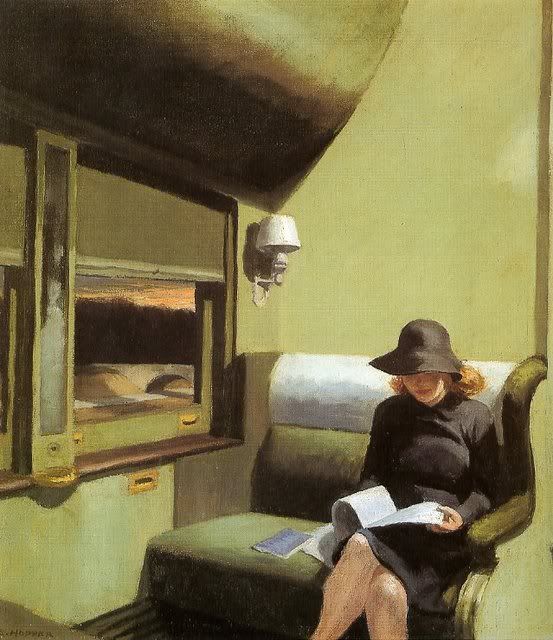
Edward Hopper, Compartment C, Car 193, 1938
___
segunda-feira, dezembro 29, 2008
Giorgio Morandi
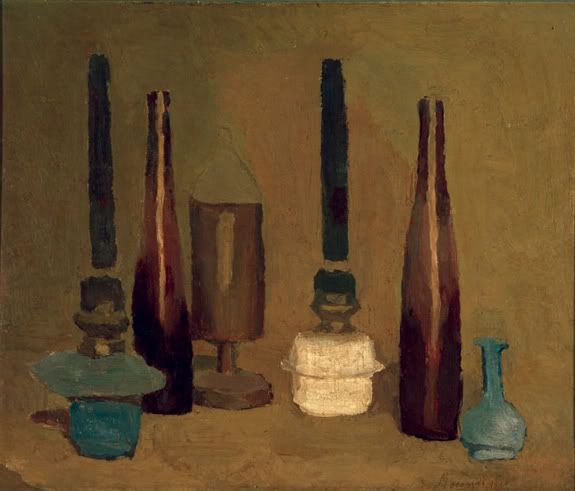
Giorgio Morandi, Still life, 1939, oil on canvas
Colecção do Museu de Arte Contemporânea da Universidade de São Paulo
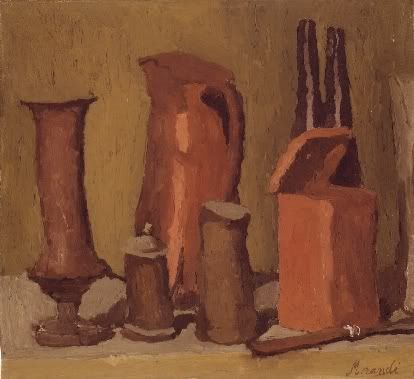
Giorgio Morandi, Still life, 1930, oil on canvas
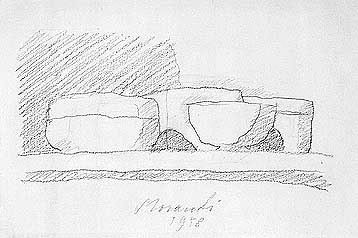
Giorgio Morandi, Still Life, 1958, pencil on paper
A exposição Giorgio Morandi 1890-1964 no Metropolitan Museum of Art, em New York, encerrou a 14 de Dezembro. A seguir, estará patente no MAMbo, Museo d'Arte Moderna di Bologna, de 22 de Janeiro a 13 de Abril de 2009.
«On the occasion of the show (which makes its only other stop in Bologna next year), we talked to four artists who count Morandi as a model and inspiration.
Robert Irwin
"We put on a Morandi show at Ferus. We were trying to explain to some people what a so-called abstract painting was about, and what Abstract Expressionism was all about. The best example in the world was Giorgio Morandi. Morandi, in my opinion, was the only genuine European Abstract Expressionist.
When you look at the work, you think he's painting bottles, little still-life paintings, but they weren't. Morandi came in the back door. It was almost a Zen activity. He painted the same bottles over and over and over, so it wasn't really about bottles anymore. If he was a still-life painter, he wouldn't have painted the same bottles over and over.
They're about painting - the figure-ground relationship, structure and organization. Morandi's were paintings in the purest sense of the word. They were like a mantra, repeated over and over until it was divorced from words and became pure sounds."
Vija Celmins
"I tried not to mimic him, but I did a series of paintings of objects then. He helped me drop the color I was into and helped me explore light. I think he was an influence in a broader way, saying let's just go back to looking and letting your hand make decisions. That's basically what I did. I went back to painting without trying to project so much, to express so many opinions, my ideas about what great painting was.
[Morandi's is] not really humble work, either. It's really ambitious work. It's about painting a world. The thing that amazed me most in his studio was how big the bottles were, and they were painted. He painted the bottles in various shades of gray, which catches all the light. The paintings were about a world that came from his interior, and he painted the reality to go with what he was already looking for and feeling and wanting to see.
Later, when I learned to look at painting in a more complex way, I began to see how strange and controlled the still lifes were, how strange the space was, how alive the paint was. There was this exquisite balance between the extreme stillness and the movement in his paintings. My work is quite restrained. Maybe I recognized that holding back in Morandi's work and it helped me. It gave me the courage to try, to go in that direction instead of trying to be someone else, someone more exciting maybe."
Dan McCleary
"The first time I saw the paintings and the etchings, I couldn't believe them -- the stillness, the ability to create light with such a limited palette. The paintings looked very awkward and clumsy, like they were about to fall apart. They don't look bravura, but have a radiance and beauty.
More than the paintings, the etchings have had a very direct influence on me. I have a book of Morandi etchings that's like my Bible. Wherever I go to do my printing, I bring the book with me. He believed that the line of the etching gave off light, because it's not like pen and ink, it's raised on the paper. It refracts light. (...)"
Uta Barth
"The history of Western art teaches us to interpret images, to search out and decipher symbolism, to find the narrative of what is being told. Morandi gives us none of that. He gives us silence, observation and a deep love of vision itself, vision divorced from interpretation. He invites us to see, rather than read.
This is not an easy task; I know all too well, since it is what I strive for in each body of work I have made throughout the years. I want my viewer to engage and submerge themselves in the act of looking and not in thoughts about what they are looking at. Repetition, redundancy are a path to this end. Look at one chipped and clumsy group of bottles and odd vases and one may think about what they mean; look at countless repetition of the same objects and it becomes clear that something else must be at play.
Morandi's objects are clumsy and plain, yet the paintings are some of the most beautiful I have ever seen. They are a love affair with painting, with observation and vision; humble and silent, they invite us to see. They are silent paintings stripped down to form, composition, light and color."»
in Giorgio Morandi, bottle by bottle, Los Angeles Times, Arts & Culture
A ver -
- Museo Morandi
- Giorgio Morandi e a natureza-morta na Itália, de Maria Cristina Bandera e Renato Miracco, Instituto de Estudos Avançados da Universidade de São Paulo
- Giorgio Morandi: 1890-1964, Los Angeles Times, Arts & Culture
- Giorgio Morandi, bottle by bottle, Los Angeles Times, Arts & Culture
- Astronomía de Morandi, de Antonio Muñoz Molina, El País, Cultura
___


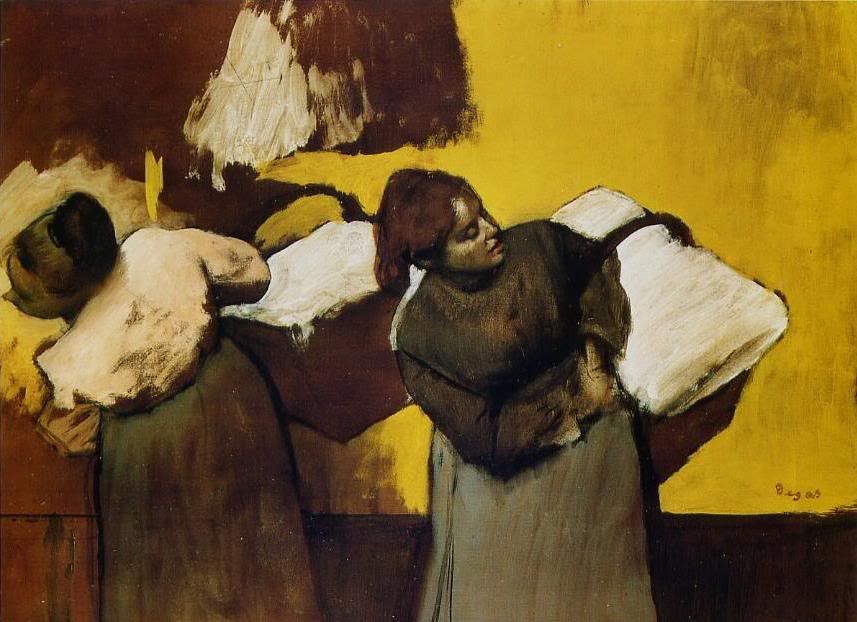


,%201988.jpg)





















